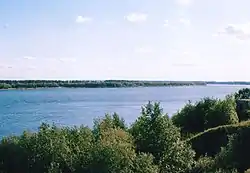Vychegda
The Vychegda (Russian: Вычегда, Komi: Эжва, Ežva) is a river in the European part of Russia, tributary to the Northern Dvina. Its length is about 1,100 kilometres (680 mi). Its source is approximately 310 kilometres (190 mi) west of the northern Ural Mountains. It flows roughly in western direction, through Komi Republic and Arkhangelsk Oblast. The largest city along the Vychegda is Syktyvkar, the capital of Komi Republic. The Viled, the Yarenga, and the Vym are among its main tributaries. The Vychegda flows into the Northern Dvina in Kotlas (Arkhangelsk Oblast).
| Vychegda Russian: Вычегда | |
|---|---|
 The lower course of the Vychegda | |
| Location | |
| Country | Russia |
| Physical characteristics | |
| Mouth | Northern Dvina |
• coordinates | 61.282°N 46.60°E |
• elevation | 41 m (135 ft) |
| Length | 1,130 km (702 mi)[1] |
| Basin size | 121,000 square kilometres (47,000 sq mi)[1] |
| Basin features | |
| Progression | Northern Dvina→ White Sea |
| Tributaries | |
| • left | North Keltma, Sysola, Viled |
| • right | Vishera, Vym, Yarenga, Berdyshevka |

The river basin of the Vychegda comprises vast areas in Arkhangelsk Oblast and in the Komi Republic, as well as less extended areas in Kirov Oblast and Perm Krai.
About 800 kilometres (500 mi) of the Vychegda is navigable. In 1822 the Vychegda was connected to the river Kama, tributary of the river Volga, by the Northern Catherine Canal, which, however, has been disused since 1838. In summer there is regular passenger navigation connecting Kotlas and Soyga (located approximately halfway between Solvychegodsk and Yarensk).
History
The area was originally populated by Finno-Ugric peoples and then colonized by the Novgorod Republic. Solvychegodsk was founded in the 14th century, Yarensk has been known since 1374. The area was attractive in the first instance because of the fur trading. From the Northern Dvina, the merchants wento to the Vychegda, and further they could get directly to the river basin of the Pechora via either the Cherya and the Izhma, or the Mylva.[2]
Name
The Russian name – Vychegda – is believed to come from an ancient Ob-Ugric name with the meaning "meadow river" (reconstructed as *vič-oxt, compare Mansi wānsi "grass" and āxt "stream"). Komi Ežva is a calque from this name: eža "meadow" and va "water, river".
References
- Вычегда. Great Soviet Encyclopedia. Retrieved 18 June 2020.
- Плечко, Л.А. (1985). Старинные водные пути (in Russian). Moscow: Физкультура и спорт.
External links
![]() Media related to Vychegda River at Wikimedia Commons
Media related to Vychegda River at Wikimedia Commons
- Река Вычегда (in Russian). State Water Register of Russia. Retrieved 2 August 2011.